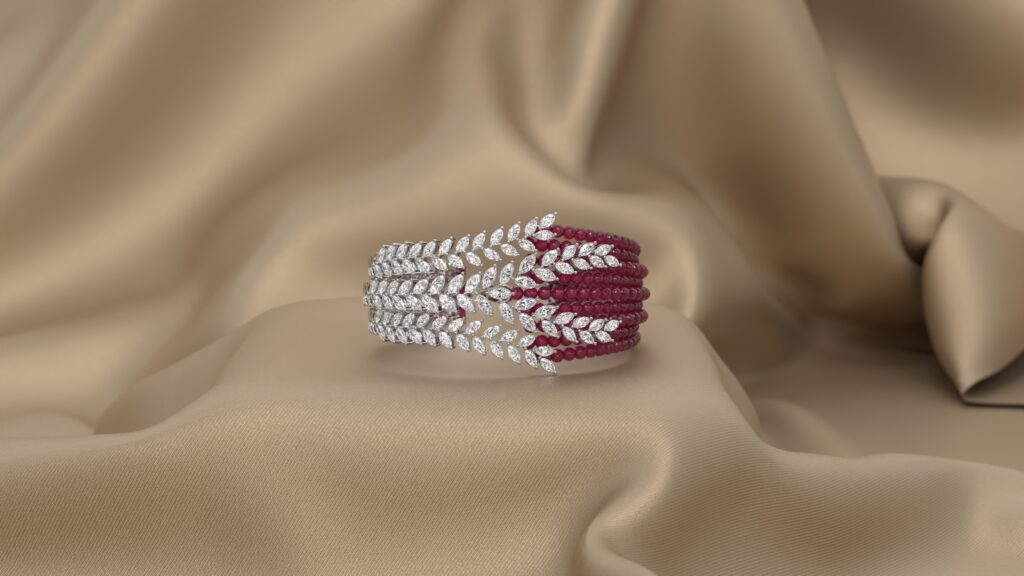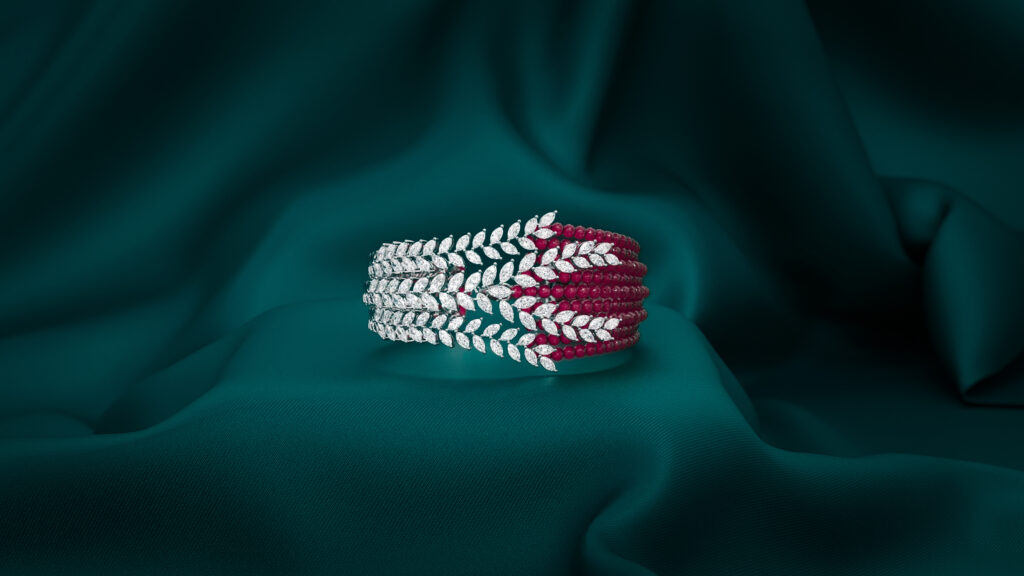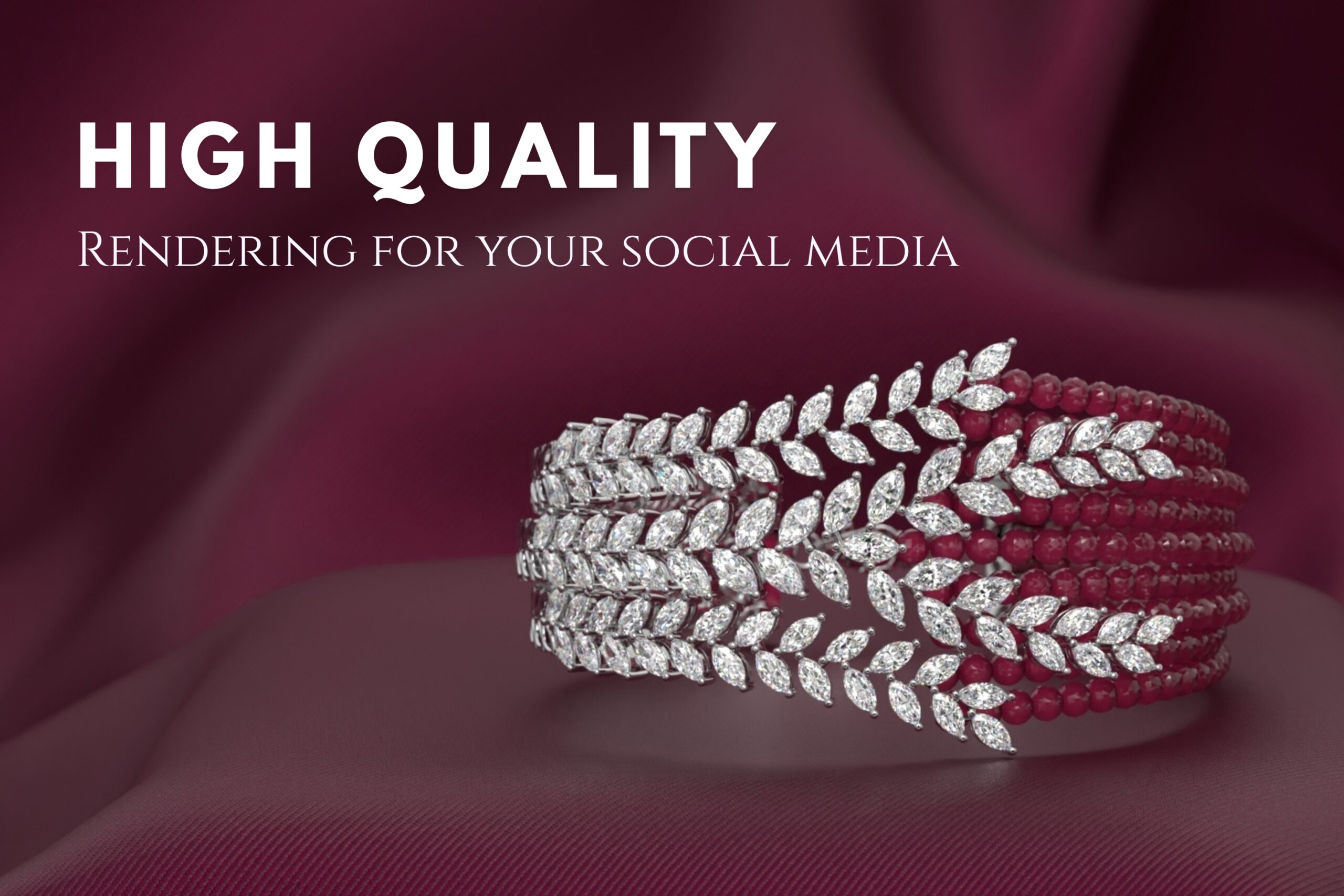Rendering Jewelry for Social Media: Visuals That Convert
In the visually-driven world of Instagram, TikTok, and Pinterest, visuals are everything for jewelry brands. Your images and videos are your digital storefront, and first impressions count. With the rise of 3D jewelry rendering and hyper-realistic videos, the standards for what captivates an audience have soared. This guide is here to help. We’ll answer the most common questions your brand might have about creating photorealistic jewelry visuals that not only stop the scroll but also convert viewers into loyal customers.
The Importance of Visual Storytelling for Jewelry Brands on Social Media
On social media, you aren’t just selling a product; you’re selling a story, a feeling, a piece of art. Visual storytelling allows you to communicate your brand’s identity and the inspiration behind your design process. It’s what separates a memorable brand from just another product in a crowded feed. Are you conveying luxury, modernism, or timeless elegance?
Your jewelry visualization choices directly impact how customers perceive your brand. By creating a cohesive and compelling visual narrative through your marketing campaigns, you build an emotional connection with your audience. This connection is key to making your jewelry stand out and transforming passive scrollers into engaged followers and buyers in the competitive jewelry industry.
How Eye-Catching Renders Drive Clicks and Sales
Stunning visuals are the hook that pulls customers in. On social media, an eye-catching render is your first opportunity to stop someone from scrolling and encourage them to learn more. High-quality, photorealistic images create a perception of value and professionalism, which is crucial for luxury items like jewelry.
When a user sees a flawless depiction of a ring’s sparkle or a necklace’s intricate details, it builds trust and desire. This initial engagement is what drives clicks to your online stores. The more appealing and creative your jewelry rendering is, the more likely a potential customer will feel confident enough to explore your collection and make a purchase.
To optimize your renders for social media, focus on clarity, vibrant lighting, and a clean composition. Use high-resolution formats and consider creating a mix of content, including still images, 360-degree animations, and short videos. These practices ensure your visuals look professional and captivating on any device, directly contributing to higher engagement and sales.
Famous Jewelry Brands Winning with Visuals
Major luxury jewelry brands have mastered the art of visual marketing. Luxurious brands like Cartier and Bvlgari represent their jewelry with 3d visualization. They use a combination of stunning photography and photorealistic jewelry visuals to create immersive marketing campaigns that feel exclusive and aspirational. They understand that consistency in quality and style across all platforms builds a powerful brand identity.
For small designers, this level of quality is no longer out of reach. Jewelry rendering levels the playing field, allowing you to create professional-grade visuals for a new collection without the budget of a global brand. You can produce an entire catalog of images and videos, showcasing different metals and gemstones, before investing in physical inventory. This enables competitors to compete and attract the same discerning customers visually.
Here’s how different visual strategies can be applied:
| Visual Strategy | Goal | Best For |
|---|---|---|
| Studio Renders | Clean, detailed product views | E-commerce sites, catalogs, and showcasing a new collection |
| Lifestyle Renders | Creating an emotional connection | Instagram posts, ad campaigns, and brand storytelling |
| 360° Animations | Interactive product exploration | Product pages, social media stories, and highlighting details |
What type of jewelry visuals perform best on Instagram and TikTok?


On visually-focused platforms like Instagram and TikTok, dynamic content is king. While crisp, high-quality still images are essential for your feed, it’s the moving visuals that truly capture attention. Short, hyper-realistic videos, 360-degree animations showcasing a ring from every angle, and virtual try-on effects generate the highest engagement. These formats are more immersive and encourage users to watch, re-watch, and share. Think of a video that follows the light glinting off a diamond; that’s the kind of content that creates a “wow” moment.
For image formats, always use high-resolution JPEGs or PNGs to ensure your jewellery designs look sharp. For dimensions, a 4:5 vertical aspect ratio is ideal for Instagram feed posts, as it takes up more screen space. For Stories and Reels on both Instagram and TikTok, a 9:16 full-screen vertical format is the standard. Using these optimized formats for your photorealistic jewelry visuals ensures your content is presented perfectly, maximizing its impact on social media.
3D Jewelry Rendering: Revolutionizing Social Media Content
3D jewelry rendering has completely changed the game for how brands create content for online stores and social media. Starting with just a CAD model, you can generate a limitless variety of visuals without needing a physical product. This means you can launch marketing campaigns faster and test different designs with your audience before committing to production.
The quick turnaround times offered by specialized rendering services are a major advantage. Many studios, like Artpix, dego team, and finegrown, specialize in creating social media-ready images and animations, delivering photorealistic content in as little as 2-3 working days. This speed and flexibility allow you to stay nimble and responsive in the fast-paced digital world.
Why Hyper-Realistic Videos Create Viral Moments
Hyper-realistic videos have a unique ability to mesmerize viewers. Unlike static images, a video can showcase the movement, environment, and brilliance of a piece of jewelry in a way that feels tangible. When a rendered diamond scatters light just like a real one, it creates a moment of awe that makes people stop and watch. These are the kinds of viral moments that can put a brand on the map.
You can use your 3D jewelry assets to create powerful social media campaigns. Imagine a campaign built around a series of short, captivating animations revealing a new collection piece by piece. You could create close-up shots that highlight intricate details, or on-body animations that show how a necklace moves and looks when worn.
This type of content is highly shareable and effective for grabbing attention in paid ads or organic posts. By leveraging jewelry rendering for video, you’re not just showing a product; you’re creating an experience that feels luxurious and unforgettable, driving both engagement and brand awareness.
Best Practices for Creating Scroll-Stopping Jewelry Renders
Creating photorealistic images that truly stop the scroll requires a blend of technical skill and artistic vision. It all starts with a high-quality 3D model, often created in jewelry-specific CAD software like Rhinoceros 3D or Matrix Gold. The precision of this initial model is the foundation for a believable final render.
From there, the focus shifts to bringing the model to life. Achieving realism in jewelry rendering isn’t just about making it look good; it’s about capturing the essence of the materials, the brilliance of the stones, and the overall mood of the piece with the storyline that connects to your customer or shows your product’s value. The next steps in the design process are critical for turning a digital file into a compelling visual asset.
Lighting Techniques for Showcasing Brilliance
In the jewelry industry, lighting is everything. It can make the difference between a flat, lifeless image and a render that perfectly captures the fire and brilliance of gemstones. The right lighting techniques are essential for creating realistic jewelry visualization that looks stunning on social media. The goal is to highlight the facets, reflections, and textures of your piece.
For social media posts, you want lighting that is both dramatic and clear. A common approach is a three-point lighting setup, which includes a key light, fill light, and back light. This combination sculpts the object, reduces harsh shadows, and creates beautiful highlights. Soft, diffused lighting works well for showcasing metals without creating distracting glares, while focused spotlights can be used to emphasize the sparkle of a diamond.
To achieve the best results, consider these lighting techniques:
- HDRI Lighting: Use High Dynamic Range Images (HDRI) as a light source to simulate realistic environmental reflections.
- Softbox Emulation: Create virtual softboxes to produce soft, even light that flatters metals and colored gemstones.
- Caustics: Enable caustics in your rendering software to simulate how light refracts through gemstones, creating realistic patterns of light and sparkle.
Styling, Angles, and Backgrounds That Convert
To make your jewelry designs stand out, you need to think like a photographer and a stylist. The angles you choose are critical. Don’t just show a front-on view. Capture close-ups of intricate engravings, side profiles of the setting, and top-down shots that showcase the main gemstone. These varied angles tell a more complete story about the craftsmanship of the piece.
Your choice of backgrounds is equally important. While a simple white or gray background is perfect for e-commerce, it can feel sterile on social media. For lifestyle or editorial-style renders, use backgrounds that evoke a mood or tell a story. This could be a soft-focus texture, a hint of a natural landscape, or an abstract color gradient that complements the jewelry. This styling helps customers visualize wearing the piece in their own lives.
Ultimately, the goal is to create a scene that feels both aspirational and authentic. Combine strategic angles with thoughtful backgrounds to showcase your jewelry in a context that resonates with your target audience. This approach transforms a simple product shot into a compelling piece of content that attracts engagement and drives conversions.
Conclusion
In conclusion, effectively rendering jewelry for social media is essential for brands looking to stand out in a visually saturated market. By leveraging the power of 3D jewelry rendering and hyper-realistic videos, you can create captivating visuals that not only attract attention but also drive engagement and sales. Remember, the key lies in understanding your audience and implementing best practices in lighting, styling, and angles to showcase your pieces. If you’re ready to elevate your brand’s visual strategy and learn more about how stunning renders can transform your social media presence, don’t hesitate to reach out for a free consultation. Let’s make your jewelry shine online!
FAQs
What image sizes and formats work best for jewelry renders on social media?
For the best quality, use high-resolution JPEG or PNG files. For Instagram and Facebook feeds, a vertical 4:5 aspect ratio is ideal. For Stories and Reels, use a 9:16 full-screen vertical format. These dimensions ensure your photorealistic images fill the screen and look professional across all devices, boosting your marketing campaigns.
Should small designers use 3D renders or traditional photos for online promotion?
For small jewelry designers, 3D jewelry rendering is often more cost-effective and flexible than traditional photography. It eliminates the need for expensive photoshoots and physical prototypes, allowing you to create a full range of visuals early in the design process. This makes high-end promotion accessible without a large budget.
What mistakes should I avoid when rendering jewelry for Instagram and Pinterest?
Avoid poor lighting that makes gemstones look dull or creates harsh reflections on metals. Ensure material textures are realistic and not plasticky. Another common mistake is using low-resolution images. Maintain precision in every detail to create a believable and high-quality jewelry visualization that captures attention on social media.

